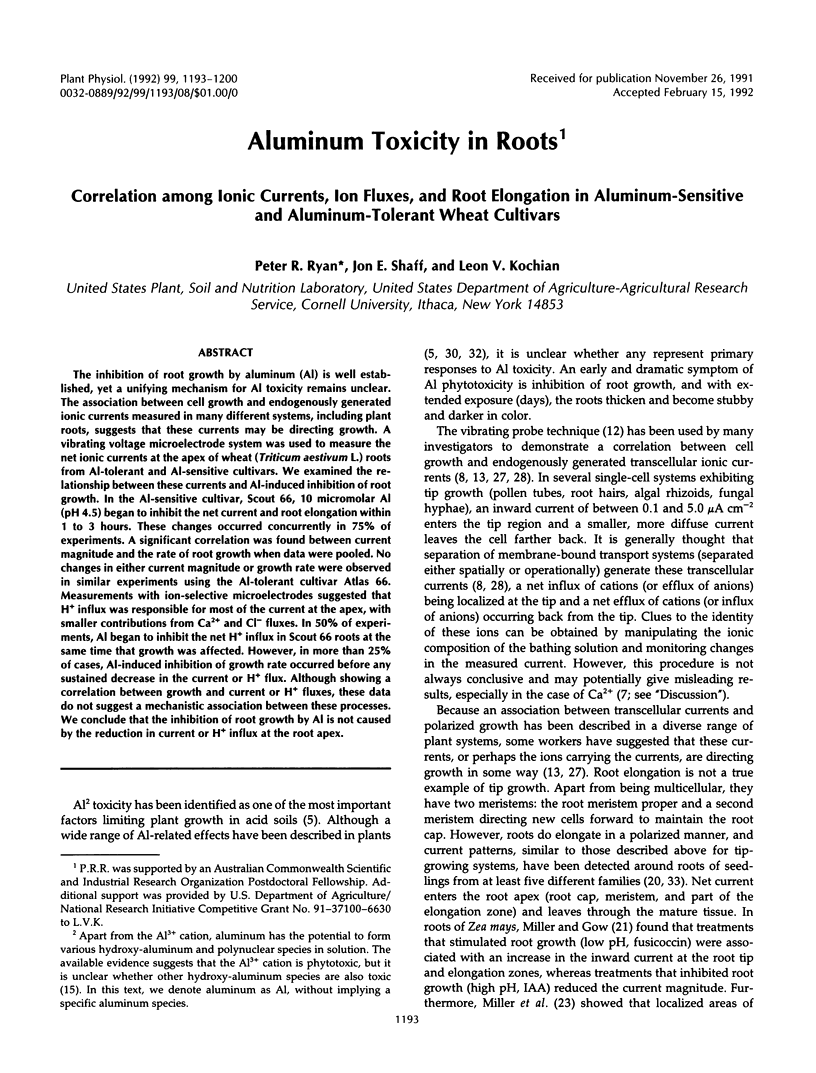Abstract
The inhibition of root growth by aluminum (Al) is well established, yet a unifying mechanism for Al toxicity remains unclear. The association between cell growth and endogenously generated ionic currents measured in many different systems, including plant roots, suggests that these currents may be directing growth. A vibrating voltage microelectrode system was used to measure the net ionic currents at the apex of wheat (Triticum aestivum L.) roots from Al-tolerant and Al-sensitive cultivars. We examined the relationship between these currents and Al-induced inhibition of root growth. In the Al-sensitive cultivar, Scout 66, 10 micromolar Al (pH 4.5) began to inhibit the net current and root elongation within 1 to 3 hours. These changes occurred concurrently in 75% of experiments. A significant correlation was found between current magnitude and the rate of root growth when data were pooled. No changes in either current magnitude or growth rate were observed in similar experiments using the Al-tolerant cultivar Atlas 66. Measurements with ion-selective microelectrodes suggested that H+ influx was responsible for most of the current at the apex, with smaller contributions from Ca2+ and Cl− fluxes. In 50% of experiments, Al began to inhibit the net H+ influx in Scott 66 roots at the same time that growth was affected. However, in more than 25% of cases, Al-induced inhibition of growth rate occurred before any sustained decrease in the current or H+ flux. Although showing a correlation between growth and current or H+ fluxes, these data do not suggest a mechanistic association between these processes. We conclude that the inhibition of root growth by Al is not caused by the reduction in current or H+ influx at the root apex.
Full text
PDF







Selected References
These references are in PubMed. This may not be the complete list of references from this article.
- Behrens H. M., Weisenseel M. H., Sievers A. Rapid Changes in the Pattern of Electric Current around the Root Tip of Lepidium sativum L. following Gravistimulation. Plant Physiol. 1982 Oct;70(4):1079–1083. doi: 10.1104/pp.70.4.1079. [DOI] [PMC free article] [PubMed] [Google Scholar]
- Ferrier J., Lucas W. J. Ion transport and the vibrating probe. Biophys J. 1986 Apr;49(4):803–807. doi: 10.1016/S0006-3495(86)83708-0. [DOI] [PMC free article] [PubMed] [Google Scholar]
- Harold F. M. To shape a cell: an inquiry into the causes of morphogenesis of microorganisms. Microbiol Rev. 1990 Dec;54(4):381–431. doi: 10.1128/mr.54.4.381-431.1990. [DOI] [PMC free article] [PubMed] [Google Scholar]
- Huang J. W., Shaff J. E., Grunes D. L., Kochian L. V. Aluminum effects on calcium fluxes at the root apex of aluminum-tolerant and aluminum-sensitive wheat cultivars. Plant Physiol. 1992 Jan;98(1):230–237. doi: 10.1104/pp.98.1.230. [DOI] [PMC free article] [PubMed] [Google Scholar]
- Jaffe L. F., Nuccitelli R. An ultrasensitive vibrating probe for measuring steady extracellular currents. J Cell Biol. 1974 Nov;63(2 Pt 1):614–628. doi: 10.1083/jcb.63.2.614. [DOI] [PMC free article] [PubMed] [Google Scholar]
- Jaffe L. F., Nuccitelli R. Electrical controls of development. Annu Rev Biophys Bioeng. 1977;6:445–476. doi: 10.1146/annurev.bb.06.060177.002305. [DOI] [PubMed] [Google Scholar]
- Jaffe L. F., Robinson K. R., Nuccitelli R. Local cation entry and self-electrophoresis as an intracellular localization mechanism. Ann N Y Acad Sci. 1974;238:372–389. doi: 10.1111/j.1749-6632.1974.tb26805.x. [DOI] [PubMed] [Google Scholar]
- Kropf D. L., Lupa M. D., Caldwell J. H., Harold F. M. Cell polarity: endogenous ion currents precede and predict branching in the water mold achyla. Science. 1983 Jun 24;220(4604):1385–1387. doi: 10.1126/science.220.4604.1385. [DOI] [PubMed] [Google Scholar]
- Miller A. L., Gow N. A. Correlation between Root-Generated Ionic Currents, pH, Fusicoccin, Indoleacetic Acid, and Growth of the Primary Root of Zea mays. Plant Physiol. 1989 Apr;89(4):1198–1206. doi: 10.1104/pp.89.4.1198. [DOI] [PMC free article] [PubMed] [Google Scholar]
- Miyasaka S. C., Kochian L. V., Shaff J. E., Foy C. D. Mechanisms of Aluminum Tolerance in Wheat : An Investigation of Genotypic Differences in Rhizosphere pH, K, and H Transport, and Root-Cell Membrane Potentials. Plant Physiol. 1989 Nov;91(3):1188–1196. doi: 10.1104/pp.91.3.1188. [DOI] [PMC free article] [PubMed] [Google Scholar]
- Newman I. A., Kochian L. V., Grusak M. A., Lucas W. J. Fluxes of h and k in corn roots : characterization and stoichiometries using ion-selective microelectrodes. Plant Physiol. 1987 Aug;84(4):1177–1184. doi: 10.1104/pp.84.4.1177. [DOI] [PMC free article] [PubMed] [Google Scholar]
- Weisenseel M. H., Dorn A., Jaffe L. F. Natural H Currents Traverse Growing Roots and Root Hairs of Barley (Hordeum vulgare L.). Plant Physiol. 1979 Sep;64(3):512–518. doi: 10.1104/pp.64.3.512. [DOI] [PMC free article] [PubMed] [Google Scholar]


